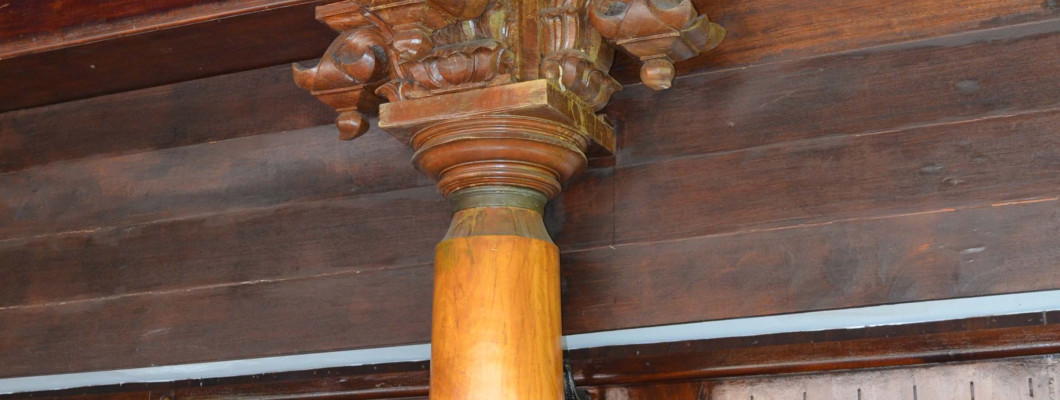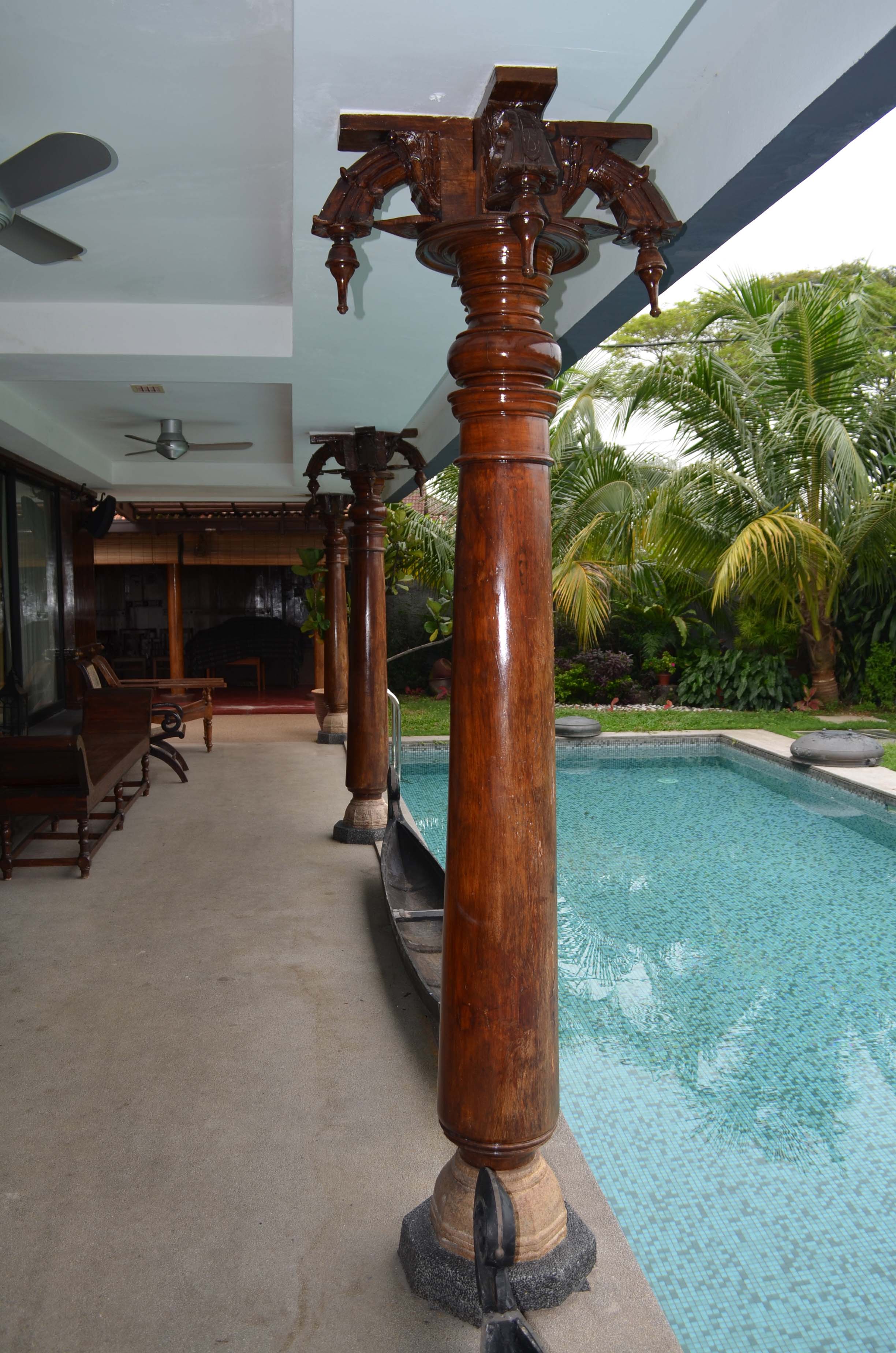

South India, well known for its rich cultural heritage, has a story of history, art, and craftsmanship to narrate. Among its many important relics, the antique pillars stand tall, as silent witnesses to centuries of tradition and creativity. These pillars are crafted with intricate carvings. They have been holding the weight not only of architectural structures it has served but also the weight of time and stories of the past it has experienced. This blog aims to explore the multifaceted storylines passed through the South Indian antique wooden pillars, shedding light on their historical, cultural, and artistic significance.
Historical Significance of South Indian Antique Wooden Pillars
The history of South Indian antique wooden pillars can be traced return to ancient times, related to the architectural marvels of temples, palaces, and traditional dwellings. The Chola, Pandya, and Vijayanagara dynasties, among others, contributed significantly to the development of architectural designs that give priority to pillars. Craftsmen of masterly skills meticulously carved tales of gods, goddesses, and mythological beings, creating cultural narratives in the grains of wood and stone.
One such considerable example is the Koodalmanikyam Bharata Temple in Thrissur, where colossal pillars explore stories from the Hindu epics. These pillars, often adorned with ornate details, serve as historical markers, reflecting the cultural aspirations of various dynasties and their architectural legacies.
Cultural Tapestry of South Indian Antique Wooden Pillars
The antique wooden pillars of South India embody a cultural tapestry that connects different regional influences. The detailed carvings on these pillars point out the region's religious diversity. They feature depictions of religious deities, mythological storylines, and sometimes traces of natural elements can also be found. These pillars with its each carving tells a story of the people, their rituals, their beliefs, their culture, their tradition and their way of life.
Furthermore, these pillars often serve as the historical representations of societal values and norms. For example, the Madurai Meenakshi Amman Temple features pillars with intricately carved figures of holy beings, reflecting the societal aspirations for spiritual elevation and harmony.
Artistic Mastery in South Indian Antique Wooden Pillars
South Indian antique wooden pillars stand as a testament to the extraordinary skill and artistic prowess of the craftsmen who dedicated their lives to this craft. The carving techniques, that have been passed down through generations, demonstrate a level of precision and finesse that is inspiring and educative to the present generation of carpenters. The motifs and designs not only showcase the artists' mastery but also provide a visual narrative that stood the test of time.
In addition to religious and mythological themes, these pillars often feature flora and fauna, geometric patterns, and scenes that hold importance from a common man’s perspective. The aesthetic appeal of the carvings, combined with the durability of the hardwood, has allowed these pillars to withstand the test of climate, time and cultural changes, preserving the artistic legacy of South Indian craftsmanship.
Architectural Functionality of South Indian Antique Wooden Pillars
Beyond their aesthetic appeal, these wooden pillars serve a crucial structural function in traditional South Indian architecture. The pillars provide support for the roof and upper floors, while creating open and well-ventilated spaces. The use of wood in the construction al,ong with open ventilated spaces, helps maintain a cool and comfortable interior, essential in the warm and humid climate of South India.
Chettinad pillars: an example for South Indian antique wooden pillars
The Nattukottai Chettiar community in the Chettinad region of Tamil Nadu state have a unique culture, heritage and cuisine for themselves. During their peak era of wealth and status, spanning a hundred years, they constructed formidable fort like mansions as their residences, adorned with the wealth amassed from distant shores.
During this era, residents adorned their homes with sturdy wooden or polished granite pillars featuring intricately carved capitals and brackets. In much older residences, tapered pillars crafted from teak sourced from Burma or satinwood from Ceylon was the preferred materials. In-depth detail was consistently devoted to the design of capitals, brackets, pedestals, and the lower sections of the pillars.
These Chettinad pillars represent the bygone era by holding dear the rich history, tradition, culture, and lifestyle of the Nattukottai Chettiar community. Each pillar serves as a historical artifact, offering insights into the era and affluence of the respective families who owned them. In the early and peak periods of Chettiar prosperity, these pillars were adorned with elaborate carvings, reflecting wealth and status. However, as time progressed, the subsequent Chettiar pillars displayed fewer carvings and details depicting a fall in their wealth.
A Touch of Tradition: Incorporating South Indian Antique Wooden Pillars into Your Space
Incorporating South Indian wooden pillars into your interior design is a way to establish a traditional and cultural connection with the past. It allows individuals to experience for themselves with reminders of the enduring aesthetics and masterly craftsmanship of the bygone era, fostering a connection between the present and the rich tapestry of history.
These architectural marvels, dating back centuries, bring a sense of history and sophistication to contemporary living spaces. Using these pillars in your space adds a historical aspect into your architectural perspective. Their history will be shared through your spaces. Their detailed carvings will add more aesthetic value to your space. Functionality plus aesthetics is why you should consider adding these historical marvels into your interior design.
Placing pillars strategically in entryways, living rooms, or dining areas can transform these spaces into sophisticated and visually striking areas. These pillars with its vertical aspect always create a sense of height, making rooms feel more expansive.
Conclusion
South Indian antique wooden pillars are more than just architectural elements; they are living artifacts that encapsulate the essence of a region's history and culture. As guardians of time, these pillars continue to stand tall. They play a crucial role in harmonising the past with the present. They always inspire a deep appreciation for the rich heritage of South Indian architecture. Efforts to preserve and celebrate these treasures are crucial in ensuring that the legacy of these wooden pillars endures for centuries to come.
HeritageArt and Architecture is at your service, ready to meet your demands for antique-style wooden pillars with enthusiasm.





